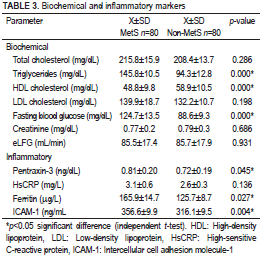Inflammatory and endothelial dysfunction markers in females with metabolic syndrome aged 50–75 years
DOI:
https://doi.org/10.17532/jhsci.2023.2003Keywords:
Ferritin, high-sensitive C-reactive protein, intercellular cell adhesion molecule-1, inflammation, metabolic syndrome, pentraxin-3Abstract
Introduction: The prevalence of metabolic syndrome (MetS) in Indonesia is 39% and it is higher in females than in males (46% vs. 28%). Features of this syndrome comprise low-grade chronic inflammation and endothelial dysfunction from cardiometabolic abnormalities. High-sensitive C-reactive protein (HsCRP) is a biomarker of cardiovascular disease, whereas ferritin and pentraxin-3 (PTX-3) are markers of chronic inflammation. One of the markers of endothelial dysfunction is an intercellular cell adhesion molecule-1 (ICAM-1). Studies on MetS in women aged 50–70 years and using several markers of inflammation and endothelial dysfunction are rare. The study aimed to determine differences in HsCRP, ferritin, PTX-3, and ICAM-1 level between females with and without MetS aged 50–75 years.
Methods: For this cross-sectional study, 160 females aged 50–75 years from South Jakarta were recruited, divided into MetS and non-MetS (control) groups, 80 participants each. Participants that met the inclusion criteria were assessed for vital signs and metabolic parameters (e.g., lipid profile, fasting blood glucose level, and waist circumference [WC]). The groups were compared using an independent t-test for inflammatory (i.e., HsCRP, PTX-3, and ferritin) and endothelial dysfunction (ICAM-1) (p < 0.05) biomarkers.
Results: The mean age of the MetS and control groups was 59.6 ± 5.6 and 59.2 ± 5.5 years. MetS criteria included WC of ≥80 cm (95.2%), increased blood pressure level (90.6%); and high-density lipoprotein cholesterol of <50 mg/dL (76.2%). Significant differences were found between the MetS and control groups for ferritin (p = 0.027), PTX-3 (p = 0.045), and ICAM-1 (p = 0.004) but not for HsCRP (p = 0.136).
Conclusion: Elevated ferritin, PTX-3 level, and ICAM-1 level are significantly associated with an increased Mets risk in females aged 50–75 years; however, the same is not true for HsCRP.
Downloads

Downloads
Published
License
Copyright (c) 2023 Pusparini, Raditya Wratsangka, Lie Tanu Merijanti, Meiyanti, Rismawati Yaswir

This work is licensed under a Creative Commons Attribution 4.0 International License.










